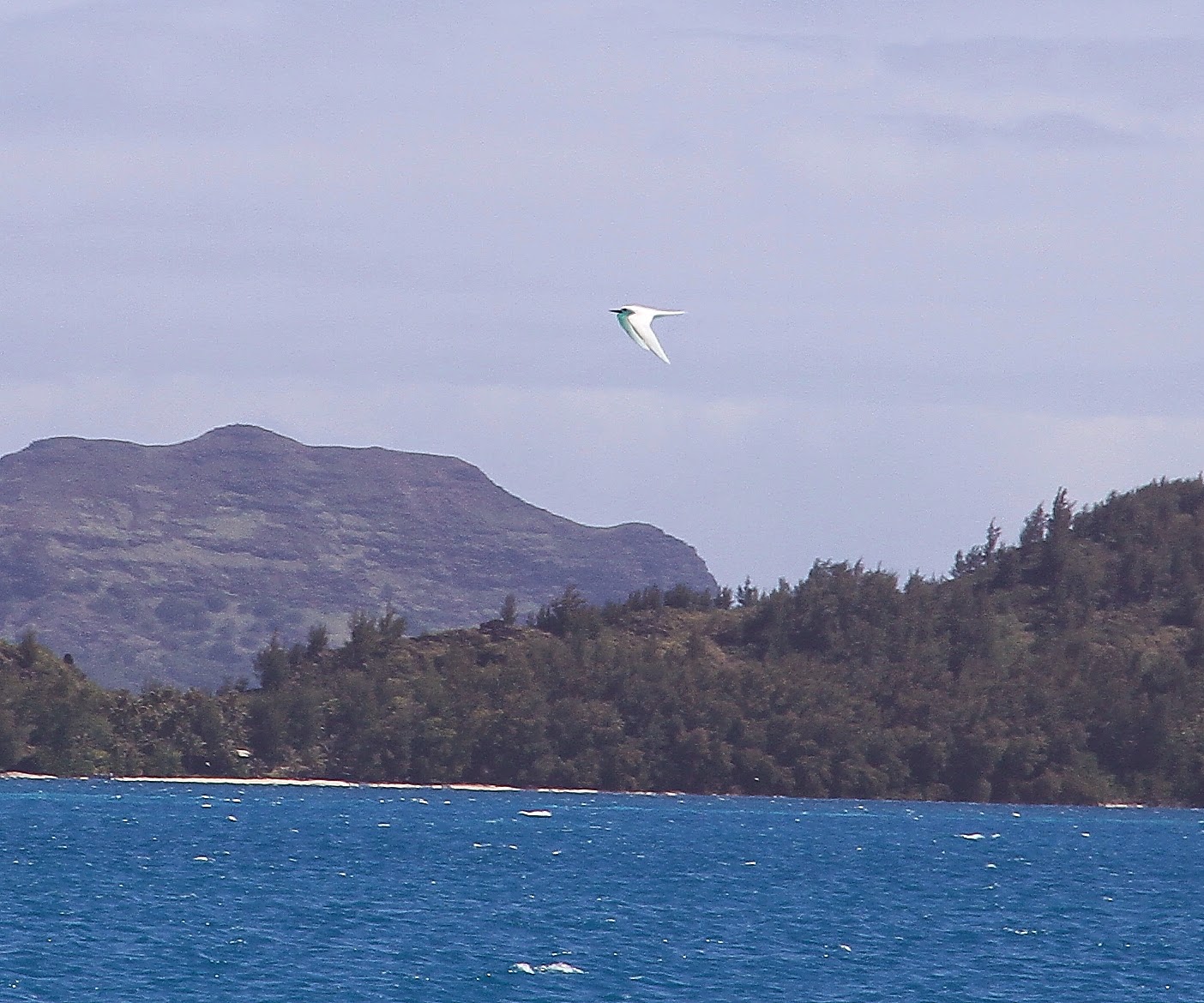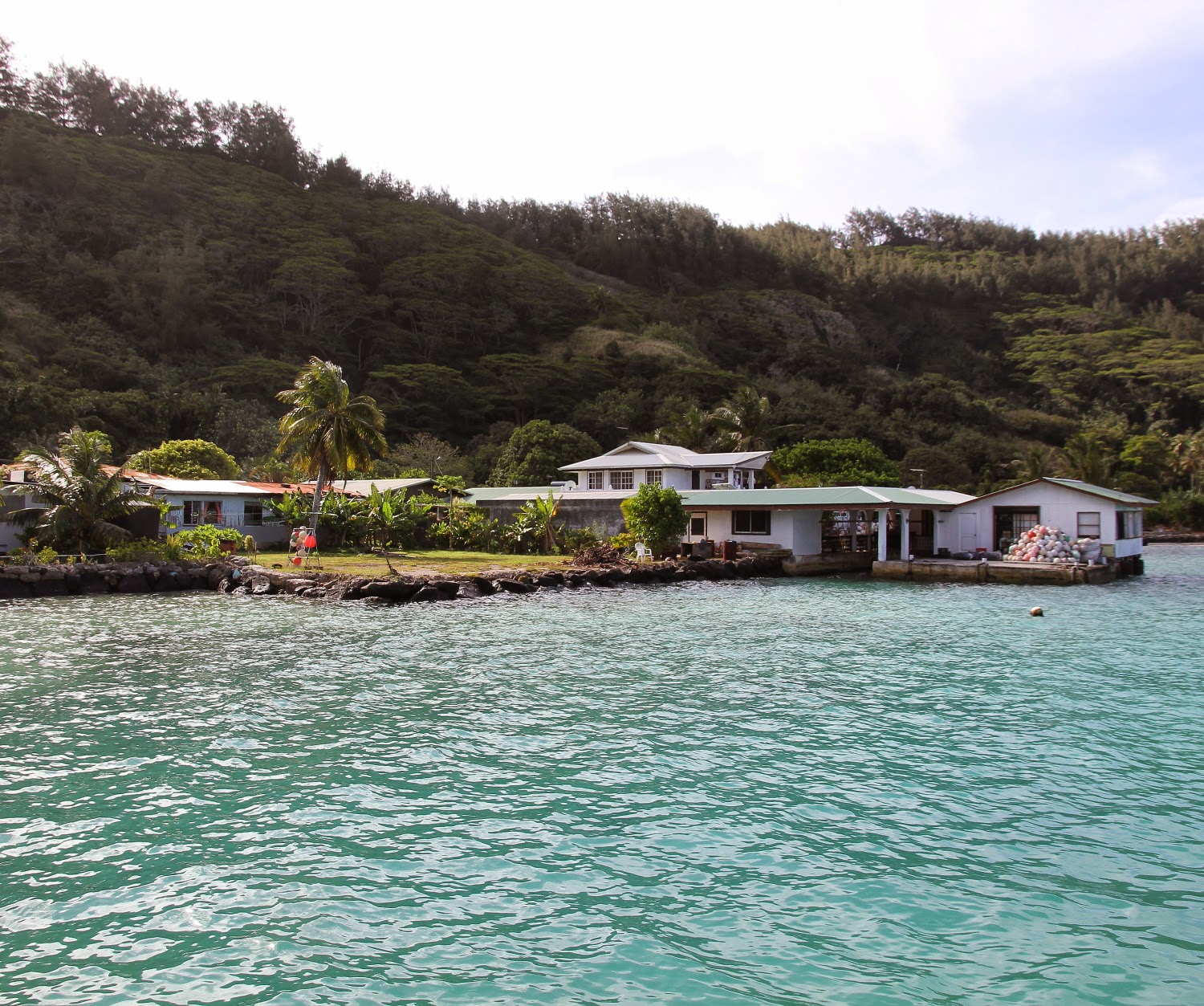We were into breakfast as it opened at 06:00 today, as we were leaving the hotel early to catch an internal flight to the island of Mangareva on the French Polynesian, Gambier Islands. This island used to produce a lot of fresh food for the French when there were conducting their early nuclear tests in the Pacific. The explosions were timed when the winds were expected to blow away from Mangareva, until they got it wrong during one atmospheric test (& contaminated their food islands). After that, they stopped taking fresh food from Mangareva & helped the island develop a successful pearl farming industry instead.
It was nice this restaurant waitress got dressed up for breakfast: But she was only good at begging for tips, rather than serving food (Zebra Dove)
Dawn view from my room's balcony
The dawn view from the infinity swimming pool looked good as well: Pity there was no time to get in there
The big problem with this internal flight was there was a 3kg limit on hand luggage. Given that was about the weight of my Canon camera & lenses, excluding the backup camera, bins, laptop & power cables, then it was time to get crafty at the checking. My backup camera was on my waist belt, the bins, camera & macro lens were around my neck, with everything else squeezed into a small daysack. Fortunately, it looked small & wasn't weighed, as it still probably over the weight limit. It could have been even harder for several of the others with much bigger & heavier lenses than I had. But, the bare-faced award of the day must go to Chris Collins, who was asked to weigh his bag in & helpfully took out his large & heavy 200-400 f4 lens (weight 3.5 kg) in front of the check-in lady to help her weight the hand luggage! It passed the weight check at that point. Finally, we were ready to board. We were at the head of the boarding queue, as it was a choose your own seats on the flight.
Views over Papeete: Note, how steeply the island rising up from the coastal plain
After a couple of hours of flying, we put down on the small island of Hao, in the Tuamotu island group. But no chance of any Tuamotu Sandpipers here as this is an inhabited island. Therefore, if they had ever occurred here, they would have died out many years ago, due to the island probably having Polynesian Rats. The island is one of a group of low lying coral atolls.
Hao: The airport is on one of a group of low lying coral atolls
Hao: These islands won't be around in a few decades if global warming continues
Hao: The end of the runway is the full width of the island
Hao: We had to leave the plane to allow it to refuel. Not surprising given the flight to the Mangareva was around a 1000 miles from Tahiti
Hao: The airport building was more basic inside than the outside looks
Hao: It was a two minute walk to the water's edge
Forty minutes after landing on Hao, we were ready to take off again for Mangareva. About two hours later, we could see the Gambier Island group. The airport is not on Mangareva, but on an atoll near to the main island.
One of the Gambier Islands: Surrounded by its own reef
The islands appear to be part of a large flooded caldera
The airport building: This was one posher as it had a small counter serving drinks & snacks
The airport island looks very like Hao
This White Tern helped to add a small Bird element to today's post
White Tern: They were fairly common here & coming close (this was taken with my 15-85 macro lens)
It's only the second time I've had to catch a boat from the airport: The other time being at Sorong airport in Irian Jaya (or its trendy new name of West Papua), the Indonesia part of New Guinea
This local was keen to get going quicker
It is a 45 minute journey across the water to the small town of Rikitea on Mangareva. This is a small place, but with better looking houses than on Tahiti. So presumably, the pearl fishing is quite lucrative.
Mangareva: This is the most densely populated part of the town
Mangareva: A great looking waterfront property
Mangareva: Even this houseboat looks plush
Alongside the quay was our boat, Braveheart, which was to be our home for the next two weeks. Apparently, She was a Japanese built boat which was over specified for its size e.g. there is a much more powerful engine than would be expected. The same high quality went into the rest of the boat. This was because she was originally built as a Japanese ship to spy on the Russians. When she was sold, there was a conversion to a larger front cabin, as there was no need for all the extra surveillance monitoring equipment in the forward compartments. She is now New Zealand owned & registered & used primarily as an expedition ship. She has sailed mainly around the South Pacific from Australia to French Polynesia. However, she has visited all parts of the Southern Oceans, including visiting Antarctica, Chile, Falklands, Heard & the Kerguelen Islands in the Indian Ocean. Therefore, she should be more than capable for the seas we were expecting to meet.
Braveheart: Only 39 metres long, but a well built boat
We were quickly relieved of our passports, so one of the crew could head off to the immigration office as we were leaving French Polynesia overnight. We were also quickly allocated cabins & it was a good time to take advantage of being still, to unpack the bags. There were six two-berth cabins. They weren't large, but they were adequate, given they were mainly only for sleeping.
The front half of my cabin: I think this was one of the smaller cabins
The Kiwi crew were a great bunch of guys & quickly got ready to put to sea. The consisted of Matt (skipper & son of the owner), Neil (skipper of the sister ship, Claymore 2), Bill (also qualified to sail the Braveheart), Charlie (cook), Elliott & Billy. Normally, the crew is only five, but she had recently lost her anchor & so we had Neil along as a second skipper.
Matt: Later in the trip as he was steering the boat using the controls on this extended cable from the roof of the bridge cabin
Getting ready to depart the quayside: L to R (Bill, Elliot, Neil & Billy)
That's the front mooring rope on board: L to R (Bill, Charlie, Elliot & Billy)
Note, the quick change to grey skies as we sail out of Mangareva



























